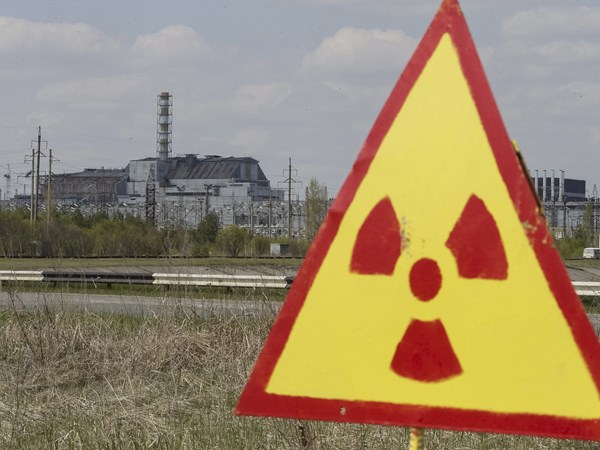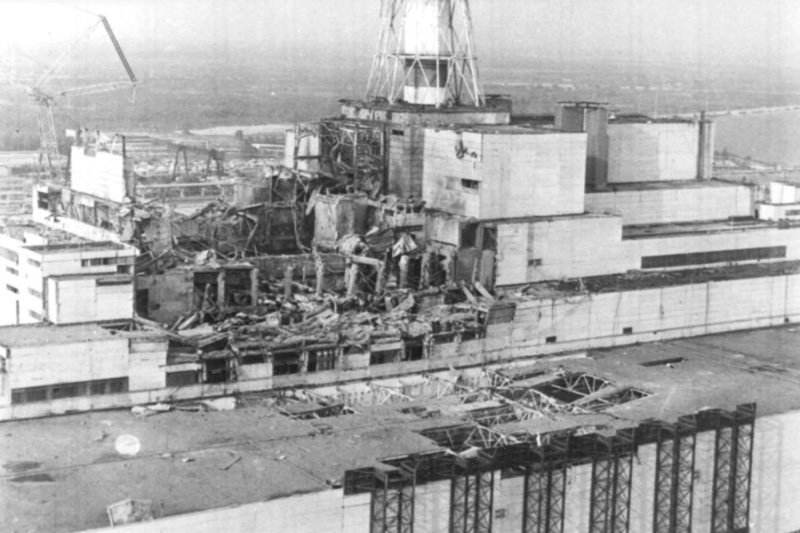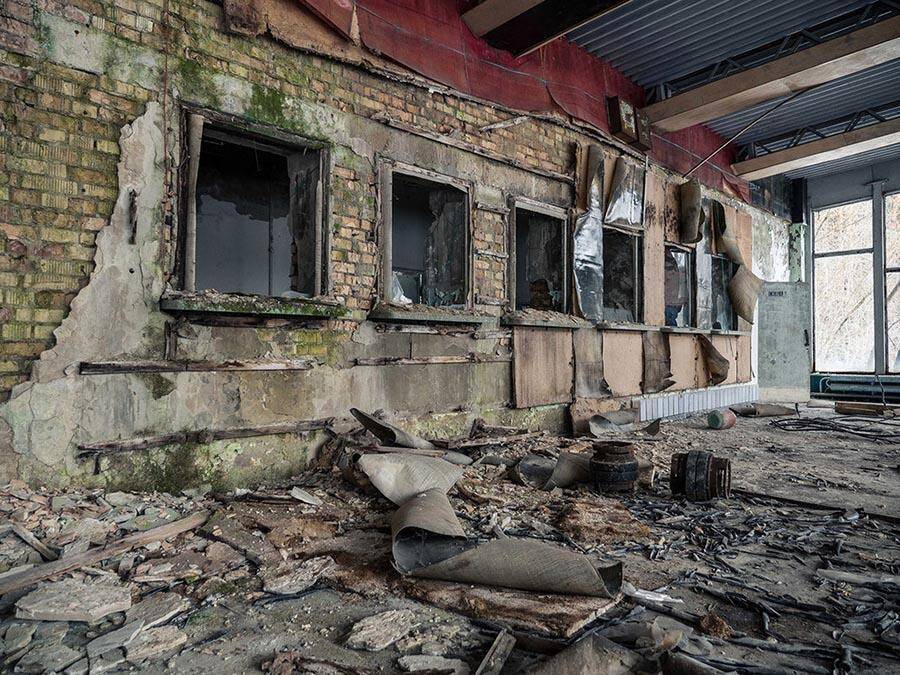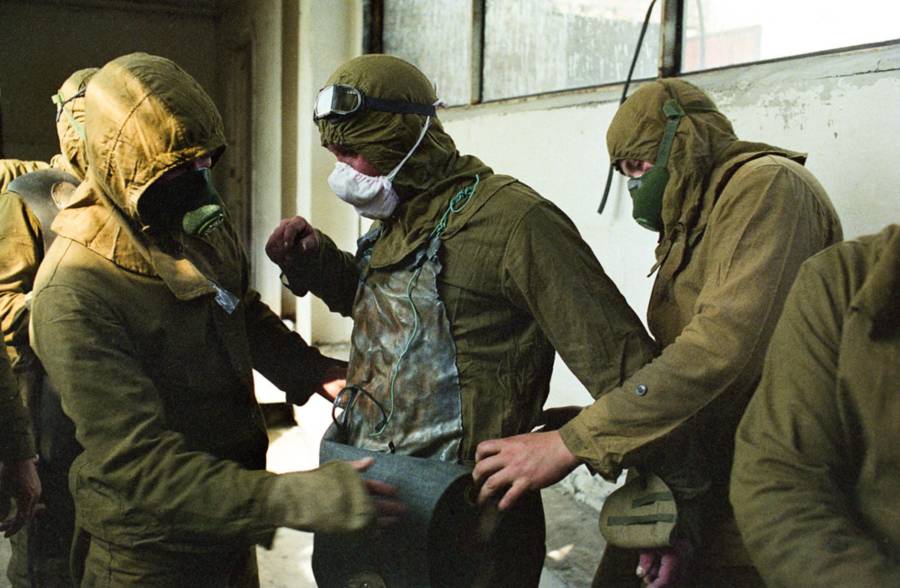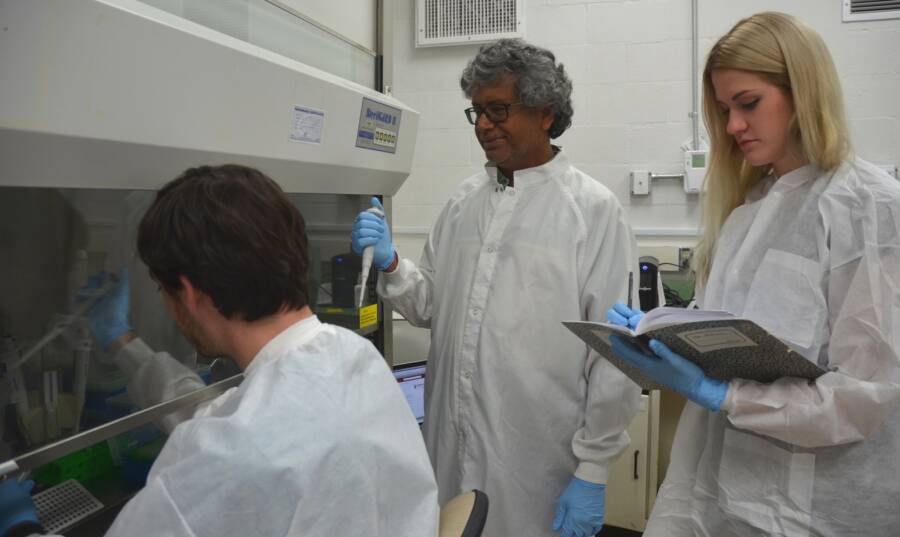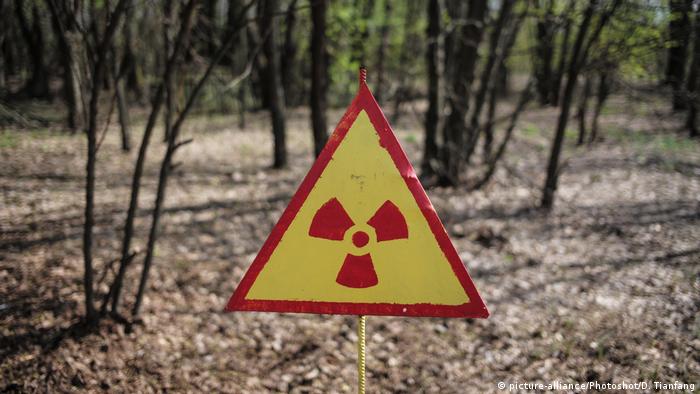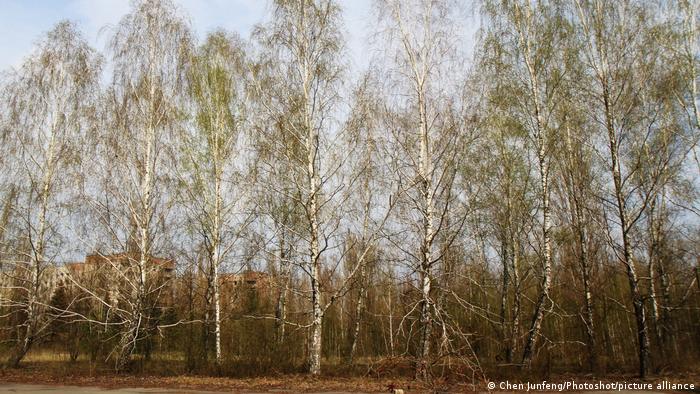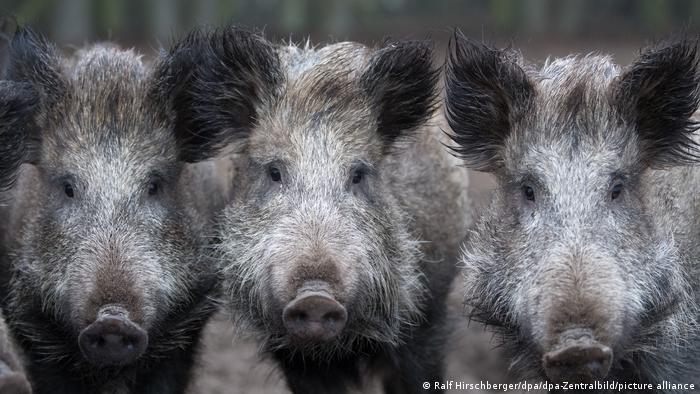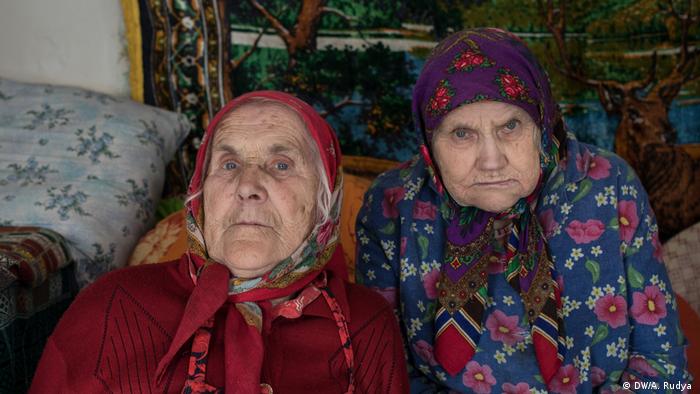Ukrainian expert: Hundreds of Russian troops received lethal dose of radiation in Chernobyl
Ukraine’s Vice Minister for Protection of the Environment and Natural Resources, Ruslan Strelets, said hundreds of Russian troops were subjected to high levels of radiation after withdrawing from Ukraine’s Chernobyl exclusion zone.
During a TV news marathon, Strelets said his agency has uncovered hundreds of bunkers and dugouts in the exclusion zone, including in the infamous Red Forest, which is among the most contaminated area around Chernobyl and gets its name from the pine trees in the forest which turned red due to high levels of radiation.
“Our specialists say that if one spends 48 hours in the Red Forest he will receive a radiation dose similar to a radiation one receives over the course of year. That is, factually anyone who was stationed there– they are the walking dead, they are people who have no chances of a future life,” Strelets exclaimed.
The Russian forces stationed around Chernobyl are believed to have been there from February 25th through March 31st, far longer than the recommended time frame.
Reports surfaced in late March claiming that Russian forces in the Red Forest area eschewed radiation protection and kicked up clouds of radioactive dust by driving armored vehicles through the area. One Chernobyl employee told Reuters that such actions were “suicidal” for Russian soldiers.
Valery Seida, acting general director of the Chernobyl plant, said of the Red Forest, "Nobody goes there ... for God's sake. There is no one there… They [Russian soldiers] drove wherever they needed to.” Seida said Russian soldiers had been warned above the radiation levels but that there is no evidence to suggest that they heeded such warnings.
The Ukrainian Ministry of Defense released drone footage on Wednesday showing what appeared to be trenches dug by Russian soldiers in the exclusion zone.
Hundreds of Russian soldiers were reportedly taken to a medical facility in the Belarusian city of Gomel to be treated for radiation poisoning, according to an employee at the Public Council at the State Agency of Ukraine for Exclusion Zone Management.

Ekaterina Maksimova
The Russian military gained access to unique materials, databases and equipment after the seizure of Ukrainian nuclear facilities and scientific laboratories. This was told to The Insider by Ukrainian nuclear scientists. The troops took control of the Zaporozhye and Chernobyl nuclear power plants, as well as their satellite cities: Enerhodar and Slavutych. In Chernobyl itself, it was reported about the looting of the "Ecocenter" - an enterprise engaged in radiation and environmental control in the exclusion zone. Equipment worth more than 6 million euros was supplied there by the European Union and Japan in the framework of joint projects with Kiev. It could be of the greatest interest to the Russian military.
On March 31, Russia withdrew its troops from the territory of the Chernobyl nuclear power plant, which was captured on the first day of the war. This was told in "Energoatom" - the operator of all nuclear power plants in Ukraine. After a 36-day occupation, Russian troops moved towards Belarus. By Thursday evening, "not a single outsider remained on the territory of the Chernobyl NPP."
The invaders took with them the Ukrainian National Guardsmen, who had been held captive since February 24. And before leaving, the Employees of the Chernobyl NPP were forced to sign a document on the absence of claims to the Russian side - the so-called "Act of Reception and Transfer of Protection of the Chernobyl Nuclear Power Plant".

This document was forced by the Russian military under pressure to sign the employees of the Chernobyl NPP
Photo: Facebook / State Agency of Ukraine for the Management of the Exclusion Zone
"These 'official' documents were signed by the station's staff under pressure to complete the process. The withdrawal of troops was accompanied by the looting of premises, as well as the theft of equipment and other valuable things," the State Agency of Ukraine for the Management of the Exclusion Zone reported.
Robbery of know-how of foreign companies
The fact that the main interest of the Russian military could be unique equipment, The Insider told An independent expert in the field of nuclear energy Olga Kosharnaya, in the past - a member of the Board of the State Nuclear Regulatory Inspectorate of Ukraine.
On March 26, the Russian military took control of the town of Slavutych, located about 50 km from Chernobyl. Many employees of the station live there. There are several enterprises of interest to Russia in the city, the expert noted. The main one is Atomremontservice, which is a division of the operator of all nuclear power plants in Ukraine. The structure is engaged in the organization of repairs at the nuclear power plant. It uses equipment to restore equipment that does not exist in Russia and the countries of the former socialist camp.
"There is a special stand of the American company Westinghouse Electric to control the geometry of the dismantling of damaged fuel elements (fuel elements) and cassettes of nuclear fuel of this manufacturer," Kosharnaya said. "The use of the stand makes it possible to identify and remove leaky elements and repair them, after which the assembly can again be operated in the reactor core before the deadline."

Westinghouse Electric fuel assembly. Photo: energyland.info
Every year, due to the depressurization of fuel elements, fuel assemblies (FUEL) fail, in Russia in this case they are prematurely unloaded from the reactors and disposed of. And the use of special equipment allows you to extend their service life, which means that you can significantly save money, as well as increase radiation safety.
It became known that during the retreat of the Russian military, at least five containers with equipment that is used in the repair of equipment disappeared. Also in the city there are unique training facilities for personnel training, devices for welding, commissioning, equipment for turbines, pumps, ventilation mechanisms, heat exchange equipment for fittings. "There is a suspicion that this will end with the robbery of the know-how of foreign companies, their intellectual property," Olga Kosharnaya noted.
What happened at Ecocenter?
The Russian military also looted the Ecocenter in Chernobyl, a unique enterprise that carried out the largest volume of radioecological research in Ukraine and accumulated a huge database. It appeared in 1986 after the accident at the Chernobyl nuclear power plant, when work began to eliminate the consequences of the disaster. Now "Ecocenter" belongs to the State Agency for the Management of the Exclusion Zone, which announced the seizure and looting of the enterprise on March 23.

View of the "Ecocenter". Photo by Facebook / Denis Vishnevsky
The key object of ecocenter is the Central Analytical Laboratory. The interlocutors of The Insider agree that, judging by the picture, the Russian military ruled here. Servers and hard drives have been ripped from computers. Olga Kosharnaya, an independent expert on nuclear energy, believes that the unique database on radiology and dosimetry, which have been collected here since the Chernobyl accident, is of particular value to Russia. All this volume of observations can now be destroyed.
Of particular value to Russia is the unique database on radiology and dosimetry collected since the Chernobyl accident: now it can be destroyed
"During the year, the laboratory collected about 5 thousand samples on a rigid system - air, water, soil, hydrobionts and much more. All this in the laboratory turned into 12 thousand results that showed the content of the main radionuclides (cesium, strontium and transuranic elements) in the selected samples. A key element in this process was the laboratory. Radiochemistry and spectrometry are very expensive and complex. Expensive equipment and consumables, expensive personnel who need to be prepared for this work for a long time, "writes Denis Vishnevsky, head of the scientific department of the Chernobyl Radiation and Ecological Biosphere Reserve.
Footage of the looted laboratory was also shown by the Russian media. They accused the Ukrainian side of "staging with the aim of discrediting the Russian military in the eyes of the public." In a story on Russia's state television channel Zvezda, one of the servicemen called the presence of radioactive samples in the laboratory a "crime," although the storage of samples is usually provided for in radioecological laboratories in Russia, Ukraine and other countries. Professor of the Institute of Radioecology of the University of Fukushima (Japan) Mark Zheleznyak told The Insider - the samples appeared in the course of research in the framework of the Japanese-Ukrainian project, in which he took part.
"There are a lot of dirty places in the zone. According to the rules, the samples were stored in special cabinets in the premises of the Ecocenter. We collected a lot of samples. After the study, the sample is still stored for further study, perhaps already other indicators. Each such laboratory has premises for the storage of samples, for that it is a laboratory. All sorts of IAEA commissions came there a hundred times, which checked this, and everything was in perfect order there, "said Professor Zheleznyak.

The laboratory of the "Ecocenter" before the invasion of the Russian military.
Radioactive isotopes, which are used to calibrate instruments, have disappeared from the laboratory of the Institute for Safety Problems of Nuclear Power Plants. It is also located in Chernobyl. In addition, samples of radioactive waste have also disappeared, including those remaining after the meltdown of the reactor contents of the Chernobyl nuclear power plant, the head of the Institute, Anatoly Nosovsky, notes in an interview with science magazine. He fears that these highly radioactive substances can be used for provocations with a "dirty bomb". This does not exclude Mark Zheleznyak. It is enough to add to the explosives the radioactive contents of the 4th power unit, taken from under the sarcophagus. You can put this into action anywhere.
"In the wagon of the Russian army"
Speaking about the Russian military, experts note their unpreparedness for being in a polluted territory. The entire zone is a huge burial ground for radioactive waste. Right in the contaminated areas in the immediate vicinity of the Chernobyl nuclear power plant, the Russians deployed a command post and placed military equipment. Including old or unusable. According to the Armed Forces of Ukraine, the 165th artillery brigade from the Amur Region operated in Chernobyl. She received permission to use the equipment in a substandard condition. This increased the risk of detonation of ammunition during loading and unloading.
And according to Olga Kosharnaya, Russian soldiers were not provided even with individual dosimeters. Radioactive contamination is spotty, that is, at one point there may be a low dose rate, and in a few meters - tens of times higher. Moving in such conditions without a radiometer is extremely dangerous. You can easily get not only a high dose of radiation, but also inhale alpha-active particles, which, apparently, happened in the Red Forest, adjacent to the Chernobyl NPP.

Gamma radiation dose rate in the Red Forest area. The maximum level in the photo is 102 μSv / h with a norm of not more than 0.2 μSv / h. 2019. Heat map made with Atom Fast 8816 scintillation dosimeter
"Without dosimetric reconnaissance with their radiochemical defense troops, they began to dig trenches in the most polluted place of the zone – the Red Forest. There was a deposition of long-lived isotopes: plutonium, uranium, americium, which emit alpha radiation. When alpha particles enter the body, damage to the kidneys, lungs and other organs begins, very quickly this can lead to cancer, "the expert believes.
On March 30, Yaroslav Emelianenko, a member of the Public Council under the State Agency of Ukraine for the Management of the Exclusion Zone, reported that several Russian servicemen had been brought from Chernobyl to the Belarusian Center for Radiation Medicine in Gomel. It was reported that these soldiers received radiation. The data was confirmed by the State Agency of Ukraine for the Management of the Exclusion Zone, but the exact number of injured soldiers was not specified, and nothing is known about their condition. The Russian Defense Ministry did not comment on the data. The IAEA said it could not confirm the information and was waiting for additional data.
Why did the military eventually leave Chernobyl?
Restoring sensor operation
After the departure of Russian troops, Ukrainian specialists will first of all have to establish the operation of sensor systems that were turned off by the invaders. In particular, the Automatic Radiation Monitoring System (ASCRO). This is a system of dosimeters in the Chernobyl exclusion zone, which in real time on the site show the level of dose rate of gamma radiation at different points of the zone.
Disabling the sensors created a dangerous situation. Fighting in the ChZO provoked forest fires in radiation-contaminated places. More than 10 hectares of forest were burning, Ukrainian ombudsman Lyudmila Denisova reported. This could be fraught with an increase in radiation levels, but without ASCRO it would not have been possible to find out about it.
Professor of the Institute of Environmental Radiology of the University of Fukushima Mark Zheleznyak told The Insider that specialists had to focus on the indicators of devices located at a distance of 100 km and further from the Chernobyl exclusion zone. These data showed only a rough picture.

